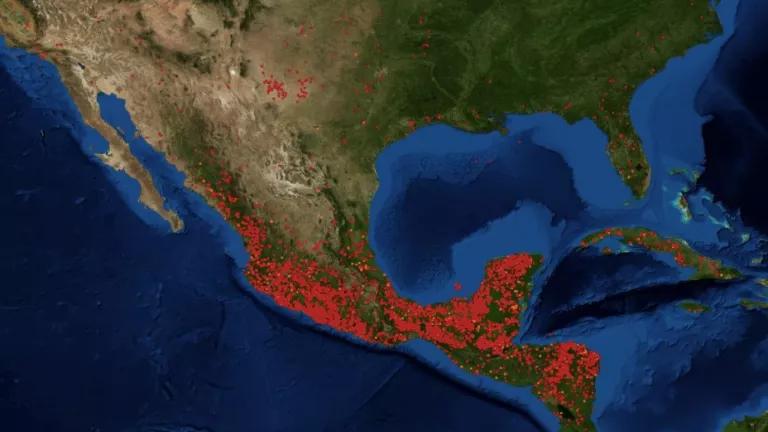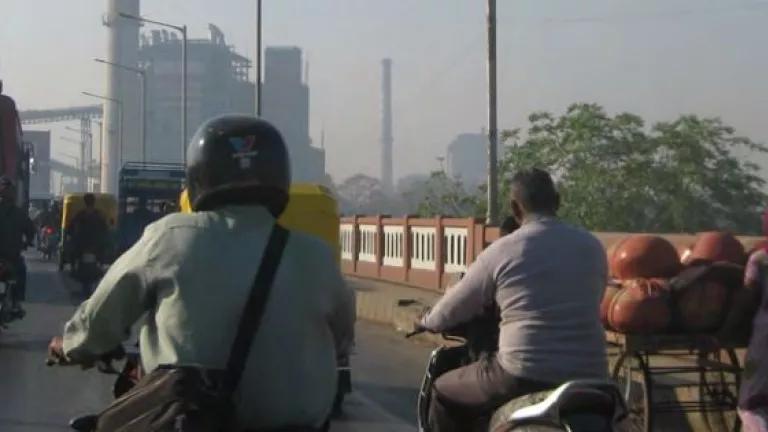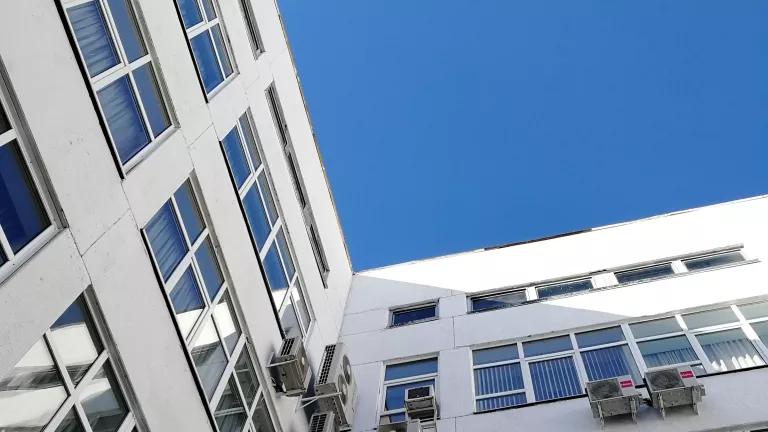Latin America’s Air Pollution Impacts Climate and Health
Air pollution is the biggest environmental risk for health in the Americas, according to the World Health Organization. The theme of World Environment Day this year is Air Pollution, and this opportunity to highlight the seriousness of the problem could not come at a better time for Latin America.

The red points represent wildfires that were active between the 11th and 12th of May.
Air pollution is the biggest environmental risk for health in the Americas, according to the World Health Organization. The theme of World Environment Day this year is Air Pollution, and this opportunity to highlight the seriousness of the problem could not come at a better time for Latin America.
Just a few weeks ago, Mexico suffered terrible air pollution when wildfires raged throughout much of the country, burning almost 849,000 acres in 32 different jurisdictions from January to May. As a result, the air quality in Mexico reached toxic levels in various states, the government closed schools, and recommended that people stay inside.
At the same time, and at the other end of Latin America, Chile is preparing for winter, the time of year when air pollution is at its worst due to the widespread use of wood for heating and cooking in homes and other buildings. Because of this, cities in central and southern Chile typically have air quality levels that are among the worst in the Western Hemisphere. Ten million Chileans live in areas that are categorized as “saturated” due to the high levels of fine particulate matter in the air.
Furthermore, most countries and cities in the region do not have standards for fuel efficiency, vehicle emissions, or fuel quality, which are generally considered to be the basic standards for creating a cleaner transportation sector. This means that the majority of light- and heavy-duty vehicles in the region emit high levels of carbon dioxide and particulate matter, worsening air pollution—and at a rate that is growing due to the increasing number of vehicles in the region.

A dense layer of fog is seen over Santiago in the winter
These sources of air pollution—vehicles, wood, and wildfires—damage public health and the climate because they contain a component of fine particulate matter (or PM2.5) called black carbon.
Black carbon is a major component of diesel engine exhaust—the black, sooty smoke that spews from tailpipes of dirty diesel cars and trucks, and wood (especially wet wood), among other sources. Health experts have found ties between exposure to black carbon and decreased vascular function and respiratory problems, including aggravated asthma, decreased lung function and lung inflammation. The World Health Organization has determined that diesel exhaust, outdoor air pollution and particulate matter (which includes black carbon) cause cancer.
Black carbon is also not good for the climate. In fact, scientists have identified black carbon as the second most powerful contributor to climate change after carbon dioxide. As a short-lived climate pollutant (SLCP), black carbon emissions last a matter of days in the atmosphere, meaning its effects can be felt almost immediately. Fortunately, that means that the benefits of reducing black carbon emissions can be felt almost immediately as well.
The good news is that countries, cities, and communities have the opportunity to fight climate change at the same time as they improve air quality for their citizens by reducing black carbon emissions in particular. What’s more, the policy and technology solutions already exist. Fuel efficiency, emissions, and fuel quality standards, as I mentioned above, are fundamental policies in cleaner transport systems around the world. Bicycles, pedestrian zones, public transport, electromobility—all can play a significant role in reducing air pollution in cities throughout Latin America.
To reduce pollution from wood burning, houses and buildings can install better insulation, which can improve the energy efficiency of those buildings and reduce the need to burn so much wood. At the same time, governments and the private sector can work to make alternative heating systems available to people, such as district heating and solar PV with residential-scale storage.
In fact, there is already a great deal of progress in Latin America in public policies, private sector initiatives, financial innovation, and civil society action, all directed towards addressing this problem. I have been lucky enough to participate in an event just last week in Santiago de Chile that was focused specifically on reducing black carbon emissions and including it, among other short-lived climate pollutants, in Chile’s international climate commitments. (Disclaimer: NRDC co-organized the evento with the InterAmerican Association for Environmental Defense and Chile’s Ministry of Enviroment.)
I’m writing this blog from the Latam Mobility Summit in Medellín, Colombia, where the hundreds of participants are enthusiastic and optimistic about the future of sustainable transport in the region.

Poster advertising a festival for cleaner air in Medellín
World Environment Day this year is an important reminder that we can address two serious problems at the same time, that is, by fighting a threat to both public health and the planet’s climate. The solutions and will already exist, so all that remains is to act.




